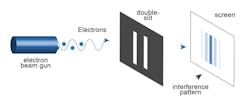Optics Learning Optics with Austin: Lesson 11 – Fringes and Interferometers
We left off in the interference post using water waves to represent the interference that occurs between light waves. A well known experiment having to do with interference of light is the double-slit experiment. In this experiment, light passes through two slits before reaching a screen. Rather than just one band of light, bands of light are separated by dark bands. These light and dark bands are called fringes.
Double Slit Experiment
Interference explains this phenomenon because light from the two slits results in both constructive and destructive interference. The bands of light indicate areas of constructive interference while the areas absent of light indicate destructive interference.
Constructive and Destructive Interference
A follow up question to fringes would be whether or not the width of fringes change due to wavelength. It turns out that the longer the wavelength (red), the wider the fringe and the shorter the wavelength (violet), the narrower the fringe. While the fringes from the double slit experiment are visible to the human eye, some fringes require special instruments to observe and measure. Interferometers use interference in measuring different types of scientific phenomenon. The LIGO interferometer is used to detect gravitational waves while the Michelson interferometer measures small movement.
Zygo Interferometer
The Zygo interferometer is used in precision optics to measure the surface of a lens. This practical application of interference tests the surface precision of the lens (discussed in lens requirement post). In reading a Zygo interferometer, PV = maximum – minimum which gives the range. The RMS in turn is the root mean square which indicates a smoother surface the smaller the value. Since differences on the optical scale cannot be spotted by the eye, interference allows precision optic companies to remain precise in their work.

Austin from Shanghai Optics Inc
Hello! My name is Austin and I am the host for this blog. I graduated from Rutgers in May 2021 with a Bachelor’s degree in Statistics-Mathematics and History. I interned during the summer of 2021 at Shanghai Optics working on data cleaning and analysis. I was later offered to work full-time starting in September. While my initial role was in data analytics, I realized that my knowledge of the company’s products was quite shallow as a key skill for any well-trained data analyst is to know your data. That’s how I got started on my journey in learning about optics.
I found physics interesting but challenging in high school. I did not particularly enjoy classical physics and a seminar in quantum mechanics flew over my head in college. As I see first-hand how our optics works in different applications, I’m quickly beginning to realize that Photonics has the potential to shape the present and the future. Because of my newfound enthusiasm, management took notice and I am fortunate enough to begin a Physics/Photonics class sponsored by Shanghai Optics in the fall of 2021. This blog is part of my experience in taking the class and sharing with you all the wealth of knowledge I’m acquiring!
Aside from optics, some of my personal interests include studying history and going on hikes. Both activities are great opportunities to talk with other people so feel free to ask me any questions on my personal interests or the materials I post!
